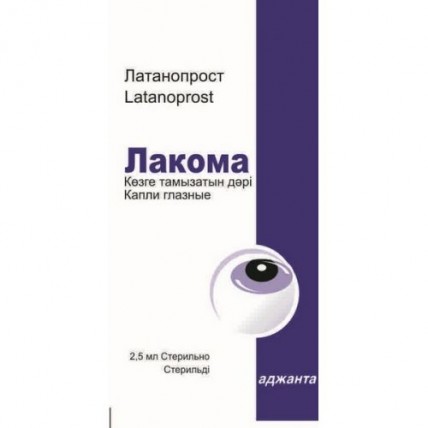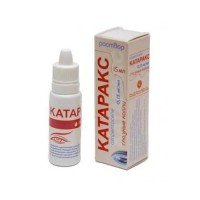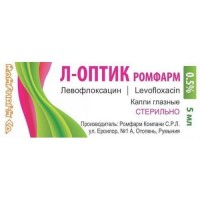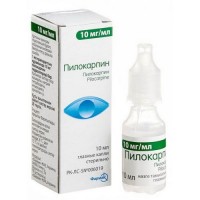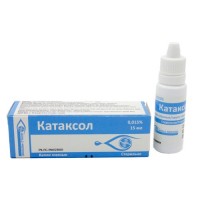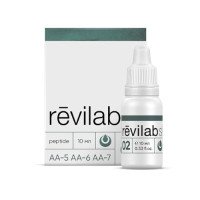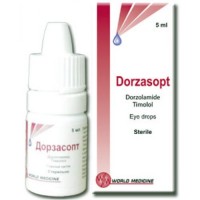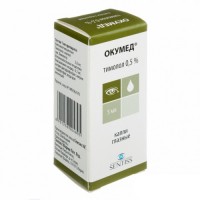Lacoma (Latanoprost) Eye Drops 2.5 ml
- $33.50
The instruction for medical use
of IS DELICIOUS medicine
the Trade name
Is delicious
the International unlicensed
name Latanoprost Lekarstvennaya
the Drop form eye 0.005%
Structure
of 1 ml of solution contains
active agent latanoprost 0.05 mg
excipients: potassium dihydrophosphate, dinatrium hydrophosphate anhydrous, a benzalkoniya chloride, sodium chloride, poliksit 40 hydrogenated castor oil, water for injections.
The description
Transparent colourless solution, without solid particles.
Pharmacotherapeutic group
Protivoglaukomny drugs and miotik. Prostaglandin analogs. Latanoprost.
The ATX S01EE01 code
the Pharmacological
Absorption of Latanoprost properties is absorbed through a cornea where in the form of isopropyl ester (inactive form) by means of esterases it is hydrolyzed to acid which is biologically active form. The maximum concentration of the latanoprost in intraocular liquid is reached approximately in two hours after topical administration.
The bioavailability
Drug is distributed first of all in an anterior chamber of an eye, in a conjunctiva and centuries. Only the insignificant amount of drug reaches a back chamber of the eye. The volume of distribution of the latanoprost at the person is equal 0.16±, 0.02 l/kg. Acid of the latanoprost is found in intraocular liquid within the first four hours, and in plasma only within the first hour after local reception.
Metabolism
of Izopropil-latanoprost is hydrolyzed by cornea esterases to biologically active acid. Active acid of the latanoprost, being soaked up in system circulation, gets into a liver and it is metabolized in it with formation of 1.2-dinor and 1,2,3,4-tetraholes of metabolites by - oxidations of fatty acids.
Excretion
latanoprost acid Elimination from plasma fast, both after intravenous administration, and after topical administration. Elimination half-life (t1/2) of acid of the latanoprost makes 17 minutes. The system clearance is equal to about 7 ml/min. After hepatic - oxidation metabolites are generally removed through kidneys. In urine after topical or intravenous administration about 88% or 98% respectively of the accepted dose are found.
Children
In clinical pharmacokinetic trial with participation of the children with intraocular hypertensia and glaucoma who were hit latanoprost 0.005% on one drop daily in each eye within 2 weeks the system exposure of acid of the latanoprost in plasma at children aged from 3 up to 12 years was approximately twice higher, and at children 3 years - 6 times higher are younger, than at adults, but at the same time the wide therapeutic range of drug for emergence of system side effects remained (see the section Overdose). The average time of achievement of the maximum concentration in blood plasma made 5 minutes after dosing in all age pediatric groups. Average plasma elimination half-life of blood was short (& lt, 20 minutes) and same as at adults, and in an equilibrium state the latanoprost acid accumulation in a big circle of blood circulation was not observed.
The pharmacodynamics
of Latanoprost - F2 prostaglandin analog, selectively stimulates prostaglandinovy receptors of FP and reduces intraocular pressure due to increase in uveoskleralny outflow of intraocular liquid and also through trabecular network.
Decrease in intraocular pressure begins approximately in 3-4 hours after administration of drug, the maximum effect is noted in 8-12 hours. Hypotensive action continues within 24 hours. Latanoprost has no significant effect on products of watery moisture and does not influence a blood-ocular barrier.
During short-term treatment latanoprost does not cause penetration of a flyuorestsein into a back segment of an eye at a psevdofakiya. At use in therapeutic doses latanoprost does not render significant pharmacological effect on cardiovascular and respiratory systems.
The efficiency in pediatrics
Efficiency of drug in clinical trials was compared to Timololum at use for children with intraocular hypertensia and glaucoma. In all studied age groups (aged from 1 to & lt, 3 years, from 3 to & lt, 12 years and from 12 to 18 years) average decrease in the intraocular pressure (VGD) from an initial indicator on the 12th week of a research in groups of treatment latanoprosty and Timololum were similar. In an age group from 0 to & lt, 1 years because of the small number of patients (4 patients) of the corresponding efficiency is not revealed. Data on efficiency at premature babies (whose gestational age was also lt, 36 weeks) are absent.
Children with primary congenital glaucoma / glaucoma of babies (PVG) had an identical decrease in VGD in group of the latanoprost and group of Timololum. Results in subgroup of patients with ne-PVG (for example, a juvenile open angle glaucoma, afakichny glaucoma) and sick PVG were similar.
The efficiency of drug in the form of decrease in VGD became noticeable after the first week of treatment and remained within 12 weeks of a research, just as, and at adults.
Indications
- decrease in the increased intraocular pressure at patients with an open angle glaucoma, chronic closed-angle glaucoma and with eye hypertensia
- decrease in the increased intraocular pressure at children with the increased intraocular pressure and glaucoma
the Route of administration and doses
Adult (including elderly patients)
On one drop in the affected eye once a day.
The optimum effect is reached at use Are delicious in the evening.
Frequency of use of drug should not exceed once a day as it is established that at more frequent use the efficiency of drug decreases.
If one dose was passed, then further it is necessary to continue treatment, entering the following dose as usual.
Drug can be used along with other eye thaws for decrease in VGD. If more than one local ophthalmologic solution are used, medicine should be taken, at least, with a difference five minutes.
Contact lenses should be deleted before use of eye drops, and can be newly put on in fifteen minutes. (See the section Special instructions).
Children
use Drug in the same dosage, as well as the adult.
Data on efficiency of drug at premature children (gestational age less than 36 weeks) are absent, at babies 1 years are younger are limited.
Side effects
- irritation of eyes (burning, granularity, an itching, feeling of pricking and a foreign body), blepharitis, conjunctiva hyperaemia, eye pain, the increased pigmentation of an iris of the eye (See the section Special instructions), temporary dot epithelial erosion, the century
- skin rash
- dizziness, a headache
- hypostasis of a cornea and an erosion, conjunctivitis, changes of growth of eyelashes and a vellus hair (increase in length, thickness, pigmentation and number), inflammation of an iris of the eye an eye / uveitis, a keratitis, macular hypostasis, including the cystous macular hypostasis, growth of eyelashes in the wrong direction sometimes leading to irritation of an eye, the obscured sight, a photophobia, periorbital changes leading to formation of grooves on centuries (See the section Special instructions)
- asthma (including bad attacks or exacerbation of a disease at patients with bronchial asthma in the anamnesis), an asthma
- darkening of an eyelid skin and local skin reactions a few centuries ago
- muscle/joints pains
- an atypical stethalgia
- a herpetic keratitis
- unstable stenocardia, heartbeat
of the Contraindication
- hypersensitivity to a latanoprost or any other component of drug
- diseases of upper airways, a bronchospasm swelled
- pregnancy and the period of a lactation
Medicinal interactions
It was reported about paradoxical increase in VGD after simultaneous topical administration of two analogs of prostaglandins. Thus, simultaneous use of two or more prostaglandins, analogs of prostaglandins or derivative prostaglandins in the form of eye drops is not recommended.
Children
of the Research at children on medicinal interaction were not carried out.
Special instructions
It is delicious contains chloride a benzalkoniya which can be absorbed by contact lenses. Before burying eye drops the contact lenses should be taken out, and it is possible to insert them only in 15 minutes after burying.
It is delicious can strengthen pigmentation of an iris, it is followed by gradual change of color of eyes due to increase in content of melanin in iris stroma melanocytes. Usually brown pigmentation which is located around a pupil extends concentrically to the periphery, and all iris or its part can gain more rich brown color. Discolorations of an iris develop in most cases slowly and can remain clinically imperceptible. Discoloration in one or two eyes comes to light mainly at patients from the iris mixed by coloring which contains brown color as the main. During clinical trials the accumulation of a pigment in trabecular network or in any other department of an anterior chamber of an eye is not revealed. Drug does not affect a nevus of an iris of the eye,
accumulation of a pigment in trabecular network or an anterior chamber of an eye during clinical trials is noted.
When determining extent of pigmentation of an iris within more than 5 years, undesirable consequences of strengthening of pigmentation even are not revealed at therapy continuation latanoprosty. Patients had an identical extent of decrease in VGD regardless of existence or lack of strengthening of pigmentation of an iris. Therefore, treatment latanoprosty can be continued also in cases of strengthening of pigmentation of an iris. Such patients have to be under regular observation and, depending on a clinical situation, treatment can be stopped.
Strengthening of pigmentation of an iris is usually observed within the first year after an initiation of treatment, is rare within the second or third year, after the fourth year of treatment this effect was not observed. Pigmentation progressing speed decreases and stabilized in 5 years over time. After the termination of treatment of strengthening of brown pigmentation of an iris it was not noted, however discoloration of eyes can be irreversible.
Due to the use of the latanoprost, cases of darkening of an eyelid skin which can be reversible are described.
It is delicious can cause gradual changes of eyelashes and vellus hair, such as lengthening, thickening, pigmentation strengthening, increase in density and change of the direction of growth of eyelashes. Changes of eyelashes are reversible and take place after the treatment termination.
At the patients applying drops only in one eye the development of heterochromia is possible.
Due to the treatment latanoprosty cases of macular hypostasis, including cystous macular hypostasis were noted. These cases took place mainly at patients with an aphakia, a psevdofakiya with a rupture of the back capsule of a crystalline lens, at patients with the known risk factors of developing macular hypostasis. Therefore these patients should use drug with care.
There are limited data on use of drug in inflammatory neovascular glaucoma. Therefore, drug is recommended to be used at these states with care.
There is a limited experience of use of drug for patients with asthma. It was reported about some cases of exacerbation of asthma and short wind. Therefore patients with asthma need to use drug with care.
It is delicious it has to be applied with care at patients with a herpetic keratitis in the anamnesis and it is necessary to avoid use of drug in cases of the keratitis caused by Herpes simplex, and at patients with a recurrent herpetic keratitis in the anamnesis, especially connected with analogs of prostaglandins.
Use for children
Data on efficiency and safety in an age group & lt, 1 years (4 patients) are very limited. Data on use for premature newborns (at which the gestational age is less than 36 weeks) are absent.
Children aged from 0 up to 3 years which have mainly primary congenital glaucoma have therapy of the first line surgical intervention (for example, trabekulotomiya / goniotomy).
Safety of prolonged use at children is not established yet.
Pregnancy and the period of a lactation, fertility
of Adequate controlled researches with participation of pregnant women were not carried out. It is necessary to appoint drug at pregnancy only when the potential advantage for mother exceeds possible risk for a fruit.
Active agent Are delicious and its metabolites can get into maternal milk therefore drug should not be used to nursing mothers or breastfeeding has to be stopped.
When carrying out researches on animals, no influence of the latanoprost for male or female fertility was observed.
Features of influence of medicine on ability to run the vehicle or potentially dangerous mechanisms Use of eye drops can cause a passing feeling of a veil before eyes within several minutes. Until this effect disappears, patients should not drive the car or to use a difficult technique.
Overdose
Symptoms: irritation of eyes and conjunctival hyperaemia.
At accidental reception of the latanoprost inside it is necessary to know that in 5 ml - the ohm a bottle contains 250 mkg of the latanoprost, more than 90% are metabolized at the first passing through a liver. Intravenous infusion in a dose of 3 mkg/kg to healthy volunteers did not cause any symptoms, but introduction of a dose of 5,510,0 mkg/kg led to nausea, an abdominal pain, dizziness, increased fatigue, inflows and excessive sweating. The sevenfold therapeutic dose of the latanoprost at use in the form of eye drops for patients with moderate bronchial asthma did not induce a bronchospasm.
Treatment at overdose: symptomatic.
The form of release and packing
On 2.5 ml or 5 ml of drug place in a plastic bottle dropper with the screw-on cap.
On 1 bottle dropper together with the instruction for medical use in the state and Russian languages place in a cardboard pack.
Storage conditions
In the place protected from light, in the fridge at a temperature from 2 of C up to 8 C. Not to freeze.
To store out of children's reach!
Period of storage
3 years. The opened bottle for use is stored at the room temperature up to 250C within 4 weeks.
Not to use after the expiration date specified on packing!
Prescription status
According to the prescription
Pharm Limited Adzhanta House Ajanta Producer, Charkop, Kandivli (Z),
Mumbai 400067, India
the Owner of the registration certificate
Ajanta Pharm Limited, India
the Address of the organization in the territory of the Republic of Kazakhstan: the accepting claim (offer) on quality of medicines from consumers, responsible for post-registration observation of safety of medicine
Republic of Kazakhstan, 050009, Almaty, Anosov St., 54/28 (ug. Roofing felt bi)
Ph. / fax: 8 (727) 374-79-50, 374-79-56,
E-mail:
To develop puneet.kapur@ajantapharma.com
of IS DELICIOUS medicine
the Trade name
Is delicious
the International unlicensed
name Latanoprost Lekarstvennaya
the Drop form eye 0.005%
Structure
of 1 ml of solution contains
active agent latanoprost 0.05 mg
excipients: potassium dihydrophosphate, dinatrium hydrophosphate anhydrous, a benzalkoniya chloride, sodium chloride, poliksit 40 hydrogenated castor oil, water for injections.
The description
Transparent colourless solution, without solid particles.
Pharmacotherapeutic group
Protivoglaukomny drugs and miotik. Prostaglandin analogs. Latanoprost.
The ATX S01EE01 code
the Pharmacological
Absorption of Latanoprost properties is absorbed through a cornea where in the form of isopropyl ester (inactive form) by means of esterases it is hydrolyzed to acid which is biologically active form. The maximum concentration of the latanoprost in intraocular liquid is reached approximately in two hours after topical administration.
The bioavailability
Drug is distributed first of all in an anterior chamber of an eye, in a conjunctiva and centuries. Only the insignificant amount of drug reaches a back chamber of the eye. The volume of distribution of the latanoprost at the person is equal 0.16±, 0.02 l/kg. Acid of the latanoprost is found in intraocular liquid within the first four hours, and in plasma only within the first hour after local reception.
Metabolism
of Izopropil-latanoprost is hydrolyzed by cornea esterases to biologically active acid. Active acid of the latanoprost, being soaked up in system circulation, gets into a liver and it is metabolized in it with formation of 1.2-dinor and 1,2,3,4-tetraholes of metabolites by - oxidations of fatty acids.
Excretion
latanoprost acid Elimination from plasma fast, both after intravenous administration, and after topical administration. Elimination half-life (t1/2) of acid of the latanoprost makes 17 minutes. The system clearance is equal to about 7 ml/min. After hepatic - oxidation metabolites are generally removed through kidneys. In urine after topical or intravenous administration about 88% or 98% respectively of the accepted dose are found.
Children
In clinical pharmacokinetic trial with participation of the children with intraocular hypertensia and glaucoma who were hit latanoprost 0.005% on one drop daily in each eye within 2 weeks the system exposure of acid of the latanoprost in plasma at children aged from 3 up to 12 years was approximately twice higher, and at children 3 years - 6 times higher are younger, than at adults, but at the same time the wide therapeutic range of drug for emergence of system side effects remained (see the section Overdose). The average time of achievement of the maximum concentration in blood plasma made 5 minutes after dosing in all age pediatric groups. Average plasma elimination half-life of blood was short (& lt, 20 minutes) and same as at adults, and in an equilibrium state the latanoprost acid accumulation in a big circle of blood circulation was not observed.
The pharmacodynamics
of Latanoprost - F2 prostaglandin analog, selectively stimulates prostaglandinovy receptors of FP and reduces intraocular pressure due to increase in uveoskleralny outflow of intraocular liquid and also through trabecular network.
Decrease in intraocular pressure begins approximately in 3-4 hours after administration of drug, the maximum effect is noted in 8-12 hours. Hypotensive action continues within 24 hours. Latanoprost has no significant effect on products of watery moisture and does not influence a blood-ocular barrier.
During short-term treatment latanoprost does not cause penetration of a flyuorestsein into a back segment of an eye at a psevdofakiya. At use in therapeutic doses latanoprost does not render significant pharmacological effect on cardiovascular and respiratory systems.
The efficiency in pediatrics
Efficiency of drug in clinical trials was compared to Timololum at use for children with intraocular hypertensia and glaucoma. In all studied age groups (aged from 1 to & lt, 3 years, from 3 to & lt, 12 years and from 12 to 18 years) average decrease in the intraocular pressure (VGD) from an initial indicator on the 12th week of a research in groups of treatment latanoprosty and Timololum were similar. In an age group from 0 to & lt, 1 years because of the small number of patients (4 patients) of the corresponding efficiency is not revealed. Data on efficiency at premature babies (whose gestational age was also lt, 36 weeks) are absent.
Children with primary congenital glaucoma / glaucoma of babies (PVG) had an identical decrease in VGD in group of the latanoprost and group of Timololum. Results in subgroup of patients with ne-PVG (for example, a juvenile open angle glaucoma, afakichny glaucoma) and sick PVG were similar.
The efficiency of drug in the form of decrease in VGD became noticeable after the first week of treatment and remained within 12 weeks of a research, just as, and at adults.
Indications
- decrease in the increased intraocular pressure at patients with an open angle glaucoma, chronic closed-angle glaucoma and with eye hypertensia
- decrease in the increased intraocular pressure at children with the increased intraocular pressure and glaucoma
the Route of administration and doses
Adult (including elderly patients)
On one drop in the affected eye once a day.
The optimum effect is reached at use Are delicious in the evening.
Frequency of use of drug should not exceed once a day as it is established that at more frequent use the efficiency of drug decreases.
If one dose was passed, then further it is necessary to continue treatment, entering the following dose as usual.
Drug can be used along with other eye thaws for decrease in VGD. If more than one local ophthalmologic solution are used, medicine should be taken, at least, with a difference five minutes.
Contact lenses should be deleted before use of eye drops, and can be newly put on in fifteen minutes. (See the section Special instructions).
Children
use Drug in the same dosage, as well as the adult.
Data on efficiency of drug at premature children (gestational age less than 36 weeks) are absent, at babies 1 years are younger are limited.
Side effects
- irritation of eyes (burning, granularity, an itching, feeling of pricking and a foreign body), blepharitis, conjunctiva hyperaemia, eye pain, the increased pigmentation of an iris of the eye (See the section Special instructions), temporary dot epithelial erosion, the century
- skin rash
- dizziness, a headache
- hypostasis of a cornea and an erosion, conjunctivitis, changes of growth of eyelashes and a vellus hair (increase in length, thickness, pigmentation and number), inflammation of an iris of the eye an eye / uveitis, a keratitis, macular hypostasis, including the cystous macular hypostasis, growth of eyelashes in the wrong direction sometimes leading to irritation of an eye, the obscured sight, a photophobia, periorbital changes leading to formation of grooves on centuries (See the section Special instructions)
- asthma (including bad attacks or exacerbation of a disease at patients with bronchial asthma in the anamnesis), an asthma
- darkening of an eyelid skin and local skin reactions a few centuries ago
- muscle/joints pains
- an atypical stethalgia
- a herpetic keratitis
- unstable stenocardia, heartbeat
of the Contraindication
- hypersensitivity to a latanoprost or any other component of drug
- diseases of upper airways, a bronchospasm swelled
- pregnancy and the period of a lactation
Medicinal interactions
It was reported about paradoxical increase in VGD after simultaneous topical administration of two analogs of prostaglandins. Thus, simultaneous use of two or more prostaglandins, analogs of prostaglandins or derivative prostaglandins in the form of eye drops is not recommended.
Children
of the Research at children on medicinal interaction were not carried out.
Special instructions
It is delicious contains chloride a benzalkoniya which can be absorbed by contact lenses. Before burying eye drops the contact lenses should be taken out, and it is possible to insert them only in 15 minutes after burying.
It is delicious can strengthen pigmentation of an iris, it is followed by gradual change of color of eyes due to increase in content of melanin in iris stroma melanocytes. Usually brown pigmentation which is located around a pupil extends concentrically to the periphery, and all iris or its part can gain more rich brown color. Discolorations of an iris develop in most cases slowly and can remain clinically imperceptible. Discoloration in one or two eyes comes to light mainly at patients from the iris mixed by coloring which contains brown color as the main. During clinical trials the accumulation of a pigment in trabecular network or in any other department of an anterior chamber of an eye is not revealed. Drug does not affect a nevus of an iris of the eye,
accumulation of a pigment in trabecular network or an anterior chamber of an eye during clinical trials is noted.
When determining extent of pigmentation of an iris within more than 5 years, undesirable consequences of strengthening of pigmentation even are not revealed at therapy continuation latanoprosty. Patients had an identical extent of decrease in VGD regardless of existence or lack of strengthening of pigmentation of an iris. Therefore, treatment latanoprosty can be continued also in cases of strengthening of pigmentation of an iris. Such patients have to be under regular observation and, depending on a clinical situation, treatment can be stopped.
Strengthening of pigmentation of an iris is usually observed within the first year after an initiation of treatment, is rare within the second or third year, after the fourth year of treatment this effect was not observed. Pigmentation progressing speed decreases and stabilized in 5 years over time. After the termination of treatment of strengthening of brown pigmentation of an iris it was not noted, however discoloration of eyes can be irreversible.
Due to the use of the latanoprost, cases of darkening of an eyelid skin which can be reversible are described.
It is delicious can cause gradual changes of eyelashes and vellus hair, such as lengthening, thickening, pigmentation strengthening, increase in density and change of the direction of growth of eyelashes. Changes of eyelashes are reversible and take place after the treatment termination.
At the patients applying drops only in one eye the development of heterochromia is possible.
Due to the treatment latanoprosty cases of macular hypostasis, including cystous macular hypostasis were noted. These cases took place mainly at patients with an aphakia, a psevdofakiya with a rupture of the back capsule of a crystalline lens, at patients with the known risk factors of developing macular hypostasis. Therefore these patients should use drug with care.
There are limited data on use of drug in inflammatory neovascular glaucoma. Therefore, drug is recommended to be used at these states with care.
There is a limited experience of use of drug for patients with asthma. It was reported about some cases of exacerbation of asthma and short wind. Therefore patients with asthma need to use drug with care.
It is delicious it has to be applied with care at patients with a herpetic keratitis in the anamnesis and it is necessary to avoid use of drug in cases of the keratitis caused by Herpes simplex, and at patients with a recurrent herpetic keratitis in the anamnesis, especially connected with analogs of prostaglandins.
Use for children
Data on efficiency and safety in an age group & lt, 1 years (4 patients) are very limited. Data on use for premature newborns (at which the gestational age is less than 36 weeks) are absent.
Children aged from 0 up to 3 years which have mainly primary congenital glaucoma have therapy of the first line surgical intervention (for example, trabekulotomiya / goniotomy).
Safety of prolonged use at children is not established yet.
Pregnancy and the period of a lactation, fertility
of Adequate controlled researches with participation of pregnant women were not carried out. It is necessary to appoint drug at pregnancy only when the potential advantage for mother exceeds possible risk for a fruit.
Active agent Are delicious and its metabolites can get into maternal milk therefore drug should not be used to nursing mothers or breastfeeding has to be stopped.
When carrying out researches on animals, no influence of the latanoprost for male or female fertility was observed.
Features of influence of medicine on ability to run the vehicle or potentially dangerous mechanisms Use of eye drops can cause a passing feeling of a veil before eyes within several minutes. Until this effect disappears, patients should not drive the car or to use a difficult technique.
Overdose
Symptoms: irritation of eyes and conjunctival hyperaemia.
At accidental reception of the latanoprost inside it is necessary to know that in 5 ml - the ohm a bottle contains 250 mkg of the latanoprost, more than 90% are metabolized at the first passing through a liver. Intravenous infusion in a dose of 3 mkg/kg to healthy volunteers did not cause any symptoms, but introduction of a dose of 5,510,0 mkg/kg led to nausea, an abdominal pain, dizziness, increased fatigue, inflows and excessive sweating. The sevenfold therapeutic dose of the latanoprost at use in the form of eye drops for patients with moderate bronchial asthma did not induce a bronchospasm.
Treatment at overdose: symptomatic.
The form of release and packing
On 2.5 ml or 5 ml of drug place in a plastic bottle dropper with the screw-on cap.
On 1 bottle dropper together with the instruction for medical use in the state and Russian languages place in a cardboard pack.
Storage conditions
In the place protected from light, in the fridge at a temperature from 2 of C up to 8 C. Not to freeze.
To store out of children's reach!
Period of storage
3 years. The opened bottle for use is stored at the room temperature up to 250C within 4 weeks.
Not to use after the expiration date specified on packing!
Prescription status
According to the prescription
Pharm Limited Adzhanta House Ajanta Producer, Charkop, Kandivli (Z),
Mumbai 400067, India
the Owner of the registration certificate
Ajanta Pharm Limited, India
the Address of the organization in the territory of the Republic of Kazakhstan: the accepting claim (offer) on quality of medicines from consumers, responsible for post-registration observation of safety of medicine
Republic of Kazakhstan, 050009, Almaty, Anosov St., 54/28 (ug. Roofing felt bi)
Ph. / fax: 8 (727) 374-79-50, 374-79-56,
E-mail:
To develop puneet.kapur@ajantapharma.com
